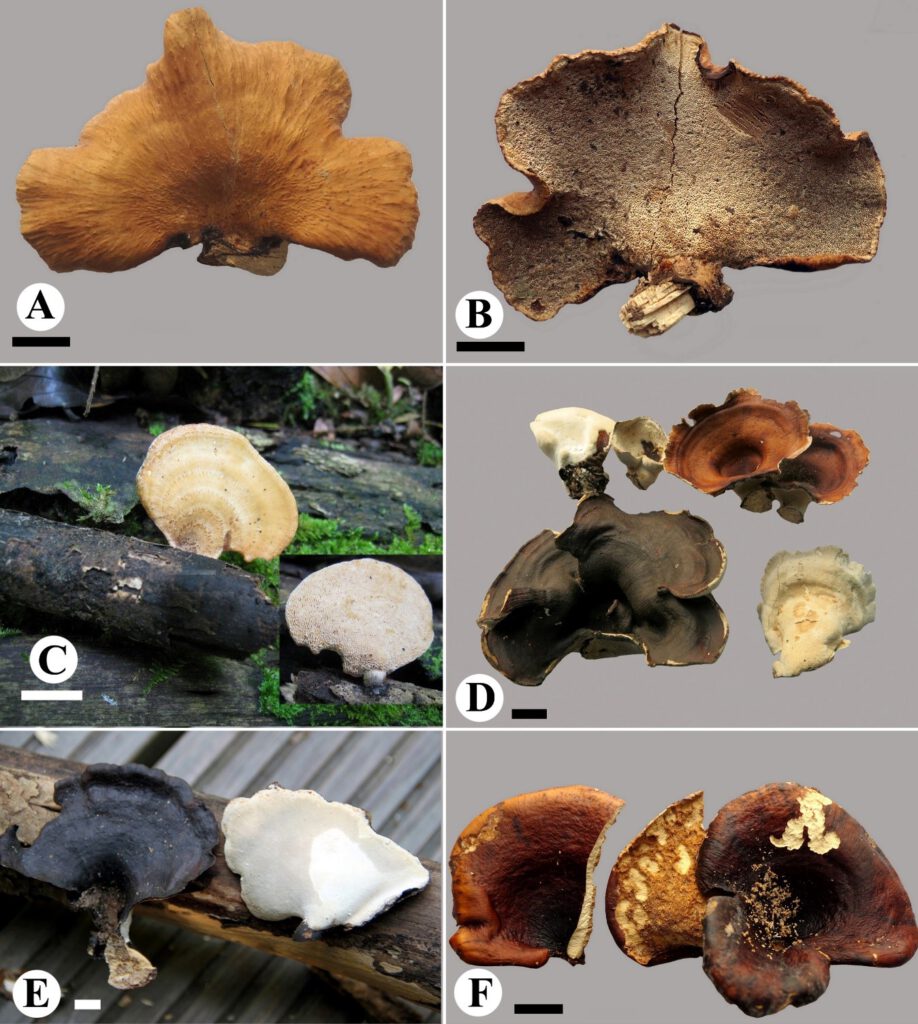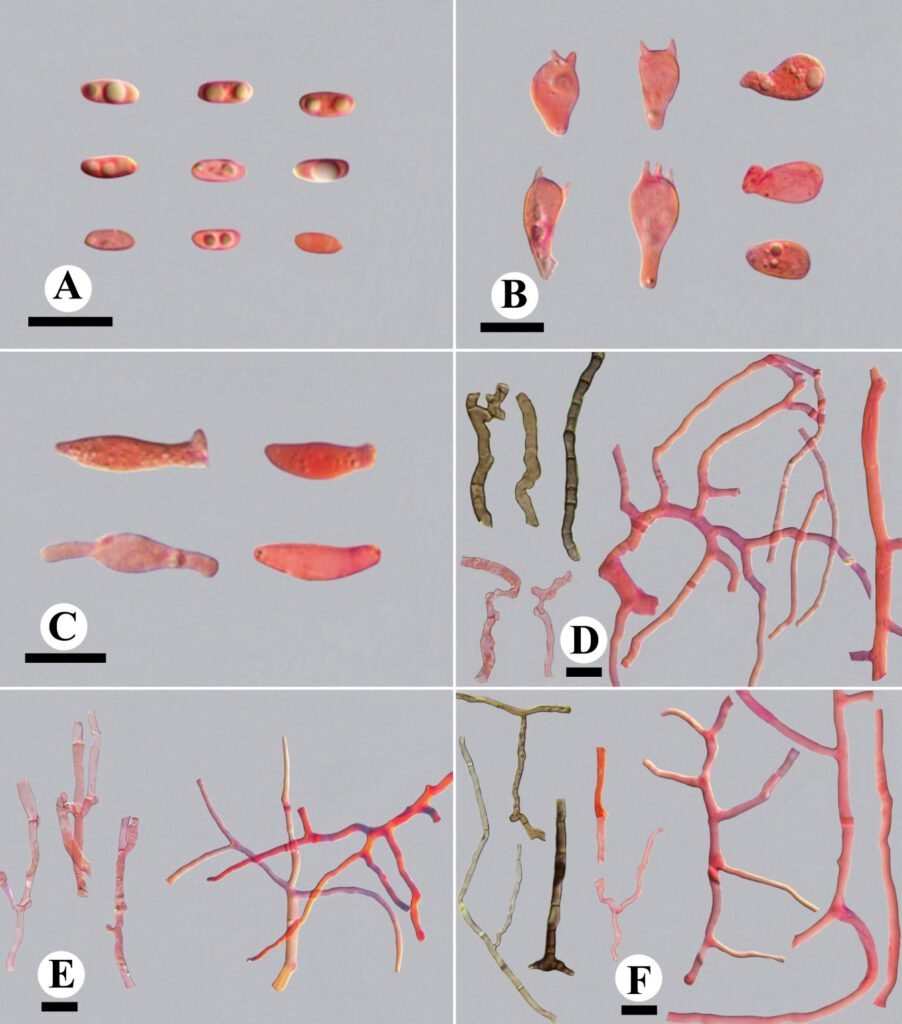Picipes atratus B.K. Cui, Xing Ji & J.L. Zhou, sp. nov.
MycoBank number: MB 559397; Index Fungorum number: IF 559397; Facesoffungi number: FoF 10645;
Description
Basidiomata – Annual, centrally to laterally stipitate, scattered to gregarious, coriaceous to hard leathery when fresh, hard woody when dry. Pilei fan-shaped to irregularly semicircular, occasionally circular with a depressed centre, projecting up to 5.8 cm long, 8.7 cm wide and 3 mm thick at base. Pileal surface white when fresh, becoming orange brown and finally black when dry, glabrous, occasionally zonate and with radially aligned stripes; margin straight. Pore surface white when young, becoming white to pale mouse-grey when mature; pores suborbicular, 7–9 per mm; dissepiments thin, entire. Context white when fresh, becoming buff when dry, up to 1 mm thick. Tubes concolorous with pore surface, decurrent on one side of the stipe, up to 2 mm thick. Stipe white with a black base when young, becoming entirely black when mature, bearing a black cuticle, glabrous, up to 1.5 cm long and 1 cm in diam.
Hyphal structure – Hyphal system dimitic; generative hyphae bearing clamp connections; skeleto-binding hyphae IKI–, CB+; tissues unchanged in KOH.
Context – Generative hyphae infrequent, colorless, thin-walled, rarely branched, 1.2–4.3 μm in diam; skeleto-binding hyphae dominant, colorless, thick-walled with a narrow lumen to solid, with arboriform branches, strongly interwoven, 1.5–6.5 μm in diam. Hyphae in cuticle with olivaceous buff to light black inclusion inside, slightly thick-walled with a wide lumen, simple-septate, 3–4.5 μm in diam.
Tubes – Generative hyphae frequent, colorless, thin-walled, frequently branched, 1.5–5.5 μm in diam; skeleto-binding hyphae dominant, colorless, thick-walled with a narrow lumen to solid, with arboriform branches, strongly interwoven, 1–5 μm in diam. Cystidia absent; cystidioles subulate, 13.5–19.5 × 4–5 μm. Basidia clavate, with a basal clamp connection and four sterigmata, 11.2–18.5 × 6.1–8.2 μm; basidioles in shape similar to basidia, but slightly smaller.
Stipe – Generative hyphae infrequent, colorless, thin-walled, rarely branched, 1–3.7 μm in diam; skeleto-binding hyphae dominant, colorless, thick-walled with a narrow lumen to solid, with arboriform branches, strongly interwoven, 1–5 μm in diam. Hyphae in cuticle with olivaceous buff to light black inclusion inside, slightly thick-walled with a wide lumen, frequently branched, simple-septate, 1–5.6 μm in diam.
Basidiospores – Basidiospores cylindrical, colorless, thin-walled, smooth, frequently bearing one or more guttules, IKI–, CB–, (5.2–)5.6–7(–7.3) × (2.3–)2.4–3(−3.1) μm, L = 6.21 ± 0.39 μm, W = 2.74 ± 0.15 μm, Q = 2–2.63, Qm = 2.27 ± 0.14 (n=144/2).
Material examined: CHINA, on living angiosperm tree, 25 October 2013, B.K. Cui, Cui 11289 (BJFC, holotype); on rotten angiosperm wood, 9 August 2013, Y.C. Dai, Dai 13375 (BJFC, paratype).
Distribution: Subtropical regions of China.
Sequence data: Cui 11289: ITS: KX900043.1 (ITS4/ITS5); LSU: KX900159.1 (LROR/LR7); nSSU: KX900271.1 (PNS1/NS41); RPB1: KX900384.1 (RPB1-Af/RPB1-Cr); RPB2: KX900307.1 (fRPB2-5F/bRPB2-7.1R); TUB: KX899935.1 (Bt-1a/Bt-1b) Dai 13375: ITS: KX900042.1 (ITS4/ITS5); LSU: KX900158.1 (LROR/LR7); nSSU: KX900270.1 (PNS1/NS41); mtSSU: KX900227.1 (MS1/MS2); RPB1: KX900383.1 (RPB1-Af/RPB1-Cr)
Fig. 1–D, E Basidiomata of Picipes atratus (D: Dai 13375, E: Cui 11289). Scale bars: 1 cm. Fig. 5 Microscopic structures of Picipes atratus. (A): Basidiospores; (B): Basidia and basidioles; (C): Cystidioles; (D): Hyphae from context; (E): Hyphae from trama; (F): Hyphae from stipe. Scale bars: A-F = 10 μm.

Fig. 1

Fig. 5
